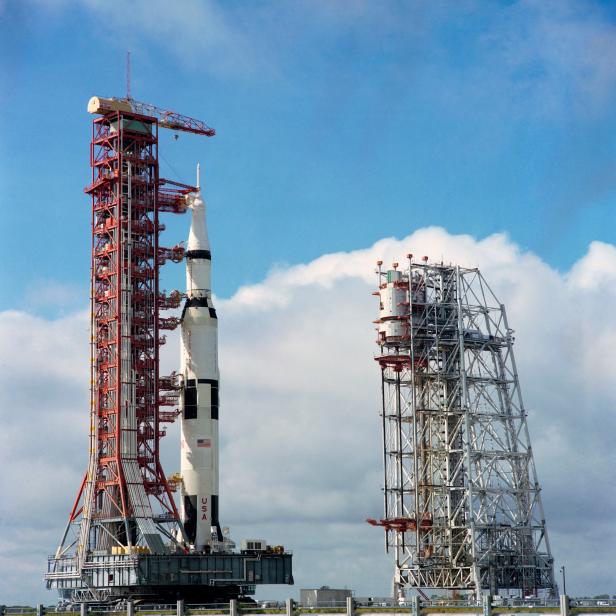
Stocktrek Images
Apollo 12: Return of the Astronaut
Apollo 12, the second manned mission to land on the Moon was anything but predictable. Here’s a look back at what happened 50 years ago today.
November 14, 1969 — humankind sets course for the moon — for the second time. Just four months after Neil Armstrong took a giant leap for mankind, Apollo 12 lifted off from Cape Kennedy, Florida. The operation was led by Mission Commander Charles “Pete” Conrad Jr., who was ascending into space for the 3rd time, after flying on Gemini 5 in 1965 and Gemini 11 in 1966. His command module Pilot was commander Richard Francis “Dick” Gordon Jr., who had also flown on Gemini 11, and lastly the Lunar Module Pilot, Commander Alan LaVern Bean. The crew sat aboard a Saturn V launcher. At the nose of the massive rocket was the LM (Landing Module) Intrepid that sat inside of, and would later be undocked from, the CSM (Control Service Module) Yankee Clipper.
The Apollo 12 mission was destined to be different. Following the success of Apollo 11, 12’s original mission of a backup landing was negated — allowing the mission to pursue much more ambitious goals. The primary focus of 11, was, of course, to put a human on the moon. Once that was accomplished the mission was chalked up to a success. 12’s goals were a little more investigative. The mission sought to become the first real manned exploration mission to the Moon.
The Goals of Apollo 12
- Test a more accurate landing technique
- Go farther from the lunar base
- Collect more geological samples
- Make a stereo and multi-spectral surface photography survey
- Set up a nuclear-powered Apollo Lunar Surface Experiments Package (ALSEP)
- Explore rugged/mountainous regions of the Moon
Lightning Strikes Twice
November 14, 1969, did not have ideal conditions for launch. A descending cold front brought overcast skies and rain. 36.5 seconds after the Saturn V rocket lifted off lighting struck. While the Saturn V rocket was unaffected, but the health of the Command Service Module (CSM) was concerning. The safety circuits in the CSM shutdown the three fuel cells that powered the spacecraft. This left the CSM on batteries only. Every warning light on the control panel lit up, the voltage dropped, and telemetry to Mission Control was interrupted. The mission faced an abort decision.
Then, 52 seconds after the Saturn V lifted off, the second lightning bolt struck. This knocked out the “8-ball” attitude indicator on the main control pane — this displays to the crew the attitude in space, angular velocity (rate) and attitude error of the spacecraft.
This could have been the end of the mission if it hadn’t been for John Aaron, the Electrical, Environmental, and Consumables Manager. John Aaron recalled a similar telemetry failure during a ground test and promptly told the flight director “Flight, EECOM. Try SCE to Aux”. What Aaron meant by this was essentially a turn it off — turn it on again fix. Sure enough, the fuel cells came back online and the mission was saved.
Guess Who’s Back?
November 19, 1969, The Intrepid lander undocks from the Yankee Clipper and began its descent to the lunar surface. Oceanus Procellarum (Ocean of Storms) was the site chosen to test a new method for making precision landings. While Apollo needed a flat, wide, elliptical area to land; the Apollo 12 would try to land within several hundred yards of a given location.
Several hours after landing, Conrad and Bean stepped out of the Intrepid and onto the lunar surface — becoming the third and fourth human beings to set foot on the Moon. Conrad showed his sense of humor as he walked down the ladder to set foot on the moon. "Whoopie! Man, that may have been a small one for Neil, but that's a long one for me." (Conrad was quite a bit shorter than Armstrong.)
By missions’ end, Conrad and Bean had spent seven hours and 45 minutes on the lunar surface. They collected 75.73 lb. of samples and had gone as far as 1,350 feet from the LM.
Home Sweet Home
Once the crew returned to the Yankee Clipper, they remained in lunar orbit for an extra day — taking additional photos and examining the Moon’s surface for future landing sites. On November 21, 1969, after completing 45 orbits and spending 88 hours and 58 minutes in space, the CSM turned engines on and Apollo 12 began its’ journey back to Earth.
November 24, 1969, The Yankee Clipper reentered Earth’s atmosphere. However, this return home was anything but predictable. Mission Control stood nervously on the ground, suspecting that the two bolts of lightning may have damaged the explosive bolts that were to deploy the parachutes. Since there was nothing that could be done, the decision was made not to inform the astronauts.
The parachutes did indeed work properly and the Command Module landed in the South Pacific Ocean. An hour after splashdown the crew was picked up by US Navy divers and were subsequently flown by helicopter to the carrier USS Hornet. The astronauts were immediately placed in the mobile quarantine facility, where they awaited a flight to the Lunar Receiving Laboratory in Houston, Texas.
And just like that, after 10 days, four hours, and 36 minutes, the Astronauts of Apollo 12 had safely returned home.



































































